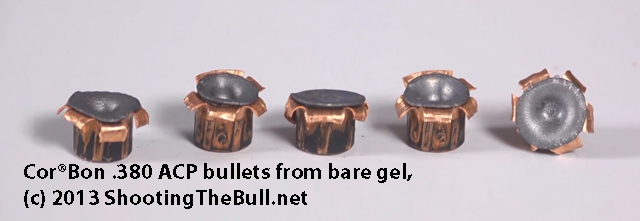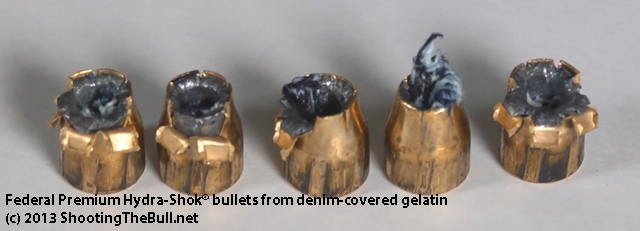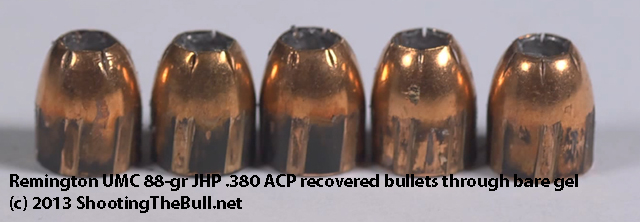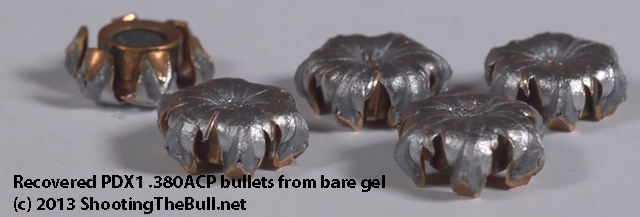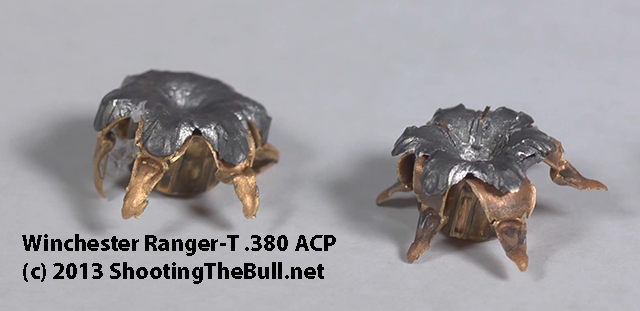In July of 2013, I picked up a little .380 pocket pistol (specifically a Taurus PT738 TCP), and I started researching what would be the most appropriate ammo to use with it.
Turns out that pretty much nobody knew. Well — I mean, sure, there’s lots of opinions, but I couldn’t find any comprehensive source of professional tests that were done from this particular barrel size, in ballistic gel, with a large sample size. I found plenty of great tests from PocketGunsAndGear that were shot with a shorter 2.5″ barrel, and some tests from tnoutdoors9 that were shot with a longer barrel, but I couldn’t find any ballistic gel tests that were shot from the 2.8″ barrel. And I knew that barrel length could affect velocity (especially as compared to the 3.5″ barrel) and that differing velocities can and will cause significant variations in expansion and penetration, so I wasn’t entirely sure that the results these other fine testers achieved would be directly applicable to these pistols with the 2.8″ barrel.
Furthermore, while I applaud the work that other testers are doing, I simply am not satisfied with a sample size of one bullet. In my experience, ammo performance can vary so widely from one shot to the next, that I believe a larger sample size is necessary in order to have an idea of how the average round of the ammo is actually likely to perform.
So, as announced in a prior post, I decided to conduct my own tests.
Testing Standards
I set as my standard the guidelines established by the 1987 and 1993 Wound Ballistic Conferences, where wound ballistics experts, medical examiners, forensic pathologists, police officers, trauma surgeons, combat surgeons, and others who worked with street shootings and bullets (and the wounds they cause) day in and day out. These were the recognized experts in their fields, and they conducted conferences to determine what properties and capabilities caused a bullet to be most effective, and how they could then develop tests that would best and most accurately reflect real-world results, so that ammo designers could then design ammo that would perform most effectively. Effectiveness was determined to be the ability to penetrate deep enough into the body to reach the vital organs (such as the heart, circulatory system, and central nervous system). A bullet that can’t reach that far, and can’t be relied upon to disrupt the vital organs, was deemed an ineffective bullet.
When it’s all boiled down to the simplest guidelines possible, the parameters work out like this, in order of importance:
- A bullet needs to have enough power to penetrate AT LEAST 12″ of soft tissue. If it can penetrate through 12″ of soft tissue, then that means it has enough power to pass through whatever combination of bone, muscle, skin, fat, and organs that it could possibly encounter, and still be able to reach the vital organs.
- A bullet should penetrate LESS than 18″ of soft tissue. Bullets that penetrated more than 18″ of soft tissue would usually end up exiting the body of the attacker, regardless of how much bone or tissue it had to pass through. That meant that the bullet posed a very real danger of overpenetration, and also that it was wasting its energy by passing completely through.
- The bigger the bullets, the better. The bigger the hole the bullet makes, the more tissue it destroys, and the more likely it is to damage vital structures that a smaller bullet might miss. In this context, expanding bullets (that penetrate deeply enough!) are much better than solid bullets, because solid bullets tend to pass right through, whereas an expanding bullet grows larger and is more likely to slow down and stop in the desired window of 12″ to 18″ of soft tissue penetration.
- Sharper bullets are better than round bullets. This isn’t the most important factor, but an expanded bullet with sharp petals on it is more likely to cut an artery or other vital structure than a round-nose bullet might, especially at the limit of travel when the bullet is going more slowly. A round-nose might just push tissue out of the way, where a sharp bullet may still be cutting and damaging tissue. This is another reason an expanded hollowpoint is a better wounder than a round-nose FMJ (Full Metal Jacket).
- Of all the parameters that matter when evaluating a bullet’s terminal performance, the most important is to achieve sufficient penetration. Overpenetration is bad, but “underpenetration will get you killed” (quote from Dr. Martin Fackler).
The FBI adopted these requirements for their duty ammo selection, which is only partially related to us in the self defense community; we’re not the FBI and we don’t need FBI duty ammo, but — ammo manufacturers love to sell ammo to the FBI, so many of the modern hollowpoint rounds on the market are designed to meet the FBI requirements. Which is good for us, because what makes a bullet effective in stopping a criminal, are the same factors that make it effective in stopping someone who’s assaulting us. The FBI requires their ammo to pass additional tests of barrier penetration, including auto windshield glass, plywood, drywall, and other tests. In the self defense community, those aren’t likely realistic tests that we need our ammo to pass, so I didn’t bother with those tests, instead I focused on the two tests that are most important to self defense shooters: the bare ballistic gelatin test, and the 4-layer denim test. The International Wound Ballistic Association standardized these two tests as a comprehensive evaluation of ammo performance in best-case and worst-case scenarios, and so that is the testing methodology I adopted.
I’ve blogged previously on the whys and wherefores of ballistic gel (for example, here, here, and here.) In the simplest terms, it’s a soft tissue simulant that we use to evaluate a bullet’s performance through soft human tissue. It’s not “jello”, it’s not a dessert, it’s actually powdered and reconstituted flesh. Professional ballistic gel is made from ground-up and powdered pork skin. It’s an effective flesh simulant because it actually is flesh. I used genuine professional 10% ordnance gelatin from www.gelatininnovations.com for the 4-layer denim test, and synthetic ClearBallistics gel from www.clearballistics.com for the bare gel tests. (I did a comprehensive comparison between the two gelatin products before starting this Ammo Quest, and found that the synthetic gel was suitable for handgun bullet testing.)
Testing Procedures
My testing procedure was to fire five shots into each block of gel, from 10 feet, through a chronograph. All 10% ballistic gel was calibrated with a steel BB at ~590 fps, was prepared to FBI specifications using FBI gel preparation procedures, stored at proper temperatures, and shot at proper temperatures, for consistent reliable data. All bullets were measured for penetration distance while they were in the block of gel, then cut out, cleaned up, measured and weighed for final details.
I tested a total of 18 types of ammunition through bare ClearBallistics gelatin. I then repeated the test in 10% calibrated ordnance gelatin through 4 layers of IWBA-spec heavy denim, for those rounds that performed well enough through the bare gelatin (or, in some cases, just because I was curious; sometimes rounds did terribly in the bare gel but I was still curious how or if they might change their performance through denim). This resulted in a grand total of 27 test videos (sheesh!)
Results
The results are correlated in the tables below. Links are provided to the YouTube tests for each round. Penetration data is color-coded; red is totally unacceptable (either gross under- or over-penetration); yellow is a bad sign (indicating modest under- or over-penetration), green is considered good, and blue is considered excellent penetration. I also include the MacPherson Wound Trauma Incapacitation value (previously blogged-about here). If you want the brief summary, bigger numbers are more effective at incapacitating an attacker (and if you want the briefest summary, just go by the color code!)
Here is a video that summarizes all my findings and makes recommendations on the various ammo that has been tested.
Below is the summary table, results, and links for the videos of all the ammo tests that were conducted.
.380 ACP Micro-Pistol With ~2.8″ Barrel
Ammunition Test Results
Buffalo Bore 90-Grain JHP Standard Pressure, Item 27G
| Average Velocity in feet per second | 937 |
| Average Expanded Diameter | .472” (12.0 mm) |
| Average Maximum Diameter | .505” (12.8 mm) |
| Average Retained Weight | 90.02 grains |
| MacPherson Wound Trauma Indicator | 18.58 |
| Penetration in Bare Gelatin, inches: | 10.88 |
| 11.13 | |
| 12.00 | |
| 23.75 | |
| 25.13 |
Copper Only Projectiles 80-grain solid copper hollowpoint
| Average Velocity in feet per second | 835 |
| Average Expanded Diameter | .433” (11.0 mm) |
| Average Maximum Diameter | .500” (12.7 mm) |
| Average Retained Weight | 79.82 grains |
| MacPherson Wound Trauma Indicator | 3.96 |
| Penetration in Bare Gelatin, inches: | 8.25 |
| 8.38 | |
| 9.13 | |
| 9.25 | |
| 9.63 |
Cor®Bon 90-Grain JHP, CorBon part # SD38090/20
| Average Velocity in feet per second | 932 |
| Average Expanded Diameter | .453” (11.5 mm) |
| Average Maximum Diameter | .512” (13.0 mm) |
| Average Retained Weight | 90.06 grains |
| MacPherson Wound Trauma Indicator | 26.35 |
| Penetration in Bare Gelatin, inches: | 11.25 |
| 12.00 | |
| 13.00 | |
| 15.50 | |
| 16.00 | |
| MacPherson WTI in Denim Test | 16 |
| Penetration in Denim gel, inches: | 22.50 |
| 22.75 | |
| 23.00 | |
| 23.50 | |
| 23.75 |
DoubleTap DT Defense Lead Free(TM) 77-grain solid copper hollowpoint
| Average Velocity in feet per second | 895 |
| Average Expanded Diameter | .358” (9.1 mm) |
| Average Maximum Diameter | .358” (9.1 mm) |
| Average Retained Weight | 77.02 grains |
| MacPherson Wound Trauma Indicator | 18.64 |
| Penetration in Bare Gelatin, inches: | 11.25 |
| 12.00 | |
| 15.50 | |
| 15.75 | |
| 19.00 |
DRT (Dynamic Research Technologies) .380 Auto 85grain HP “Penetrating Frangible”
Note: I tested this round, and it was very different, didn’t penetrate consistently, half the bullets failed entirely and just overpenetrated. It is such a different round with such different design parameters, it doesn’t fit well with making a consolidated table like the other rounds in the test. I recommend just going directly to the video to see how the DRT .380 ammo performed.
https://www.youtube.com/watch?v=Mx8pn5CadXI
Federal Premium Hydra-Shok® 90-grain JHP
| Average Velocity in feet per second | 889 |
| Average Expanded Diameter | .426” (10.8 mm) |
| Average Maximum Diameter | .487” (12.4 mm) |
| Average Retained Weight | 89.46 grains |
| MacPherson Wound Trauma Indicator | 25.68 |
| Penetration in Bare Gelatin, inches: | 12.00 |
| 12.88 | |
| 12.25 | |
| 12.75 | |
| 12.50 | |
| MacPherson WTI in Denim Test | 20.85 |
| Penetration in Denim gel, inches: | 13.50 |
| 14.00 | |
| 14.50 | |
| 15.25 | |
| 18.75 |
Fiocchi Extrema XTP(TM) 90-grain XTP JHP, part # 380XTP25
| Average Velocity in feet per second | 791 |
| Average Expanded Diameter | .414” (10.5 mm) |
| Average Maximum Diameter | .455” (11.6 mm) |
| Average Retained Weight | 89.96 grains |
| MacPherson Wound Trauma Indicator | 27.72 |
| Penetration in Bare Gelatin, inches: | 12.88 |
| 13.25 | |
| 13.50 | |
| 13.63 | |
| 13.88 | |
| MacPherson WTI in Denim Test | 25.40 |
| Penetration in Denim gel, inches: | 14.25 |
| 14.50 | |
| 15.25 | |
| 18.75 |
Note: only four bullets were used in the denim test for the Extremas.
Hornady Critical Defense(TM) 90-grain FTX® JHP with Polymer Tip
| Average Velocity in feet per second | 857 |
| Average Expanded Diameter | .478” (12.1 mm) |
| Average Maximum Diameter | .533” (13.5 mm) |
| Average Retained Weight | 88.92 grains |
| MacPherson Wound Trauma Indicator | 2.11 |
| Penetration in Bare Gelatin, inches: | 7.75 |
| 8.13 | |
| 8.25 | |
| 8.75 | |
| 8.88 | |
| MacPherson WTI in Denim Test | 18.84 |
| Penetration in Denim gel, inches: | 10.13 |
| 11.63 | |
| 11.88 | |
| 12.00 | |
| 17.00 |
Note: Critical Defense severely underpenetrated in the bare gel test. In the denim gel test we had one round travel to good penetration, but it failed to expand.
Hornady Custom .380 ACP with 90-grain XTP JHP
| Average Velocity in feet per second | 851 |
| Average Expanded Diameter | .438” (11.1 mm) |
| Average Maximum Diameter | .488” (12.4 mm) |
| Average Retained Weight | 89.96 grains |
| MacPherson Wound Trauma Indicator | 25.81 |
| Penetration in Bare Gelatin, inches: | 12.00 |
| 12.13 | |
| 12.38 | |
| 12.88 | |
| 12.88 | |
| MacPherson WTI in Denim Test | 23.80 |
| Penetration in Denim gel, inches: | 10.63 |
| 11.75 | |
| 12.75 | |
| 13.00 | |
| 13.50 |
HPR HyperClean XTP 90-grain JHP
| Average Velocity in feet per second | 789 |
| Average Expanded Diameter | .414” (10.5 mm) |
| Average Maximum Diameter | .454” (11.5 mm) |
| Average Retained Weight | 89.96 grains |
| MacPherson Wound Trauma Indicator | 27.11 |
| Penetration in Bare Gelatin, inches: | 13.50 |
| 12.50 | |
| 13.88 | |
| 14.00 | |
| 14.50 | |
| MacPherson WTI in Denim Test | 23.03 |
| Penetration in Denim gel, inches: | 12.75 |
| 13.50 | |
| 14.25 | |
| 14.88 | |
| 15.00 |
PMC Starfire(TM) 95 grain SFHP, part #380SFA
| Average Velocity in feet per second | 788 |
| Average Expanded Diameter | .381” (9.7 mm) |
| Average Maximum Diameter | .405” (10.3 mm) |
| Average Retained Weight | 95.13 grains |
| MacPherson Wound Trauma Indicator | 24.60 |
| Penetration in Bare Gelatin, inches: | 25.50 |
| 16.00 | |
| 16.00 | |
| 14.75 |
Note: only 4 bullets were tested and recovered.
Precision One .380 ACP 90 grain XTP
| Average Velocity in feet per second | 810 |
| Average Expanded Diameter | .413” (10.5 mm) |
| Average Maximum Diameter | .446” (11.3 mm) |
| Average Retained Weight | 89.78 grains |
| MacPherson Wound Trauma Indicator | 28.28 |
| Penetration in Bare Gelatin, inches: | 13.75 |
| 13.50 | |
| 13.75 | |
| 13.88 | |
| 13.63 | |
| MacPherson WTI in Denim Test | 25.72 |
| Penetration in Denim gel, inches: | 12.75 |
| 13.25 | |
| 13.75 | |
| 14.38 |
Remington Golden Saber 102-grain BJHP
| Average Velocity in feet per second | 756 |
| Average Expanded Diameter | .527” (13.4 mm) |
| Average Maximum Diameter | .624” (15.8 mm) |
| Average Retained Weight | 102.5 grains |
| MacPherson Wound Trauma Indicator | 8.89 |
| Penetration in Bare Gelatin, inches: | 10.13 |
| 8.50 | |
| 9.00 | |
| 9.38 | |
| 10.50 |
Remington UMC 88-grain JHP, part #L380A1B
| Average Velocity in feet per second | 884 |
| Average Expanded Diameter | .355” (9.0 mm) |
| Average Maximum Diameter | .355” (9.0 mm) |
| Average Retained Weight | 90 grains |
| MacPherson Wound Trauma Indicator | 16.00 |
| Penetration in Bare Gelatin, inches: | 22.75 |
| 23.25 | |
| 23.63 | |
| 24.50 | |
| 25.50 |
Note: These were hollowpoints, but all failed to expand.
Speer Gold Dot .380 ACP 90-grain GDHP, part #23606
| Average Velocity in feet per second | 944 |
| Average Expanded Diameter | .447” (11.4 mm) |
| Average Maximum Diameter | .487” (12.4 mm) |
| Average Retained Weight | 89.36 grains |
| MacPherson Wound Trauma Indicator | 23.25 |
| Penetration in Bare Gelatin, inches: | 12.00 |
| 11.75 | |
| 11.25 | |
| 11.63 | |
| 13.00 | |
| MacPherson WTI in Denim Test | 19.20 |
| Penetration in Denim gel, inches: | 10.00 |
| 11.00 | |
| 11.00 | |
| 11.50 | |
| 15.00 |
Underwood Ammo .380 ACP 102 grain Golden Saber JHP
standard pressure 950 fps, item #142
| Average Velocity in feet per second | 827 |
| Average Expanded Diameter | .503” (12.8 mm) |
| Average Maximum Diameter | .603” (15.3 mm) |
| Average Retained Weight | 101.68 grains |
| MacPherson Wound Trauma Indicator | 17.91 |
| Penetration in Bare Gelatin, inches: | 9.50 |
| 10.50 | |
| 10.75 | |
| 11.00 | |
| 12.00 | |
| MacPherson WTI in Denim Test | 16.00 |
| Penetration in Denim gel, inches: | 16.75 |
| 18.63 | |
| 19.25 | |
| 20.25 | |
| 21.25 |
Winchester PDX1® Defender(TM) 95-grain Bonded JHP
| Average Velocity in feet per second | 901 |
| Average Expanded Diameter | .562” (14.3 mm) |
| Average Maximum Diameter | .655” (16.6 mm) |
| Average Retained Weight | 95.28 grains |
| MacPherson Wound Trauma Indicator | 1.80 |
| Penetration in Bare Gelatin, inches: | 8.25 |
| 7.75 | |
| 7.63 | |
| 8.38 | |
| 9.00 | |
| MacPherson WTI in Denim Test | 2.76 |
| Penetration in Denim gel, inches: | 8.38 |
| 8.50 | |
| 8.50 | |
| 8.63 |
| Average Velocity in feet per second | 907 |
| Average Expanded Diameter | .595” (15.1 mm) |
| Average Maximum Diameter | .793” (20.1 mm) |
| Average Retained Weight | 93.9 grains |
| MacPherson Wound Trauma Indicator | 12.07 |
| Penetration in Bare Gelatin, inches: | 21.25 |
| 21.88 | |
| 15.00 | |
| 8.13 | |
| 9.50 |



